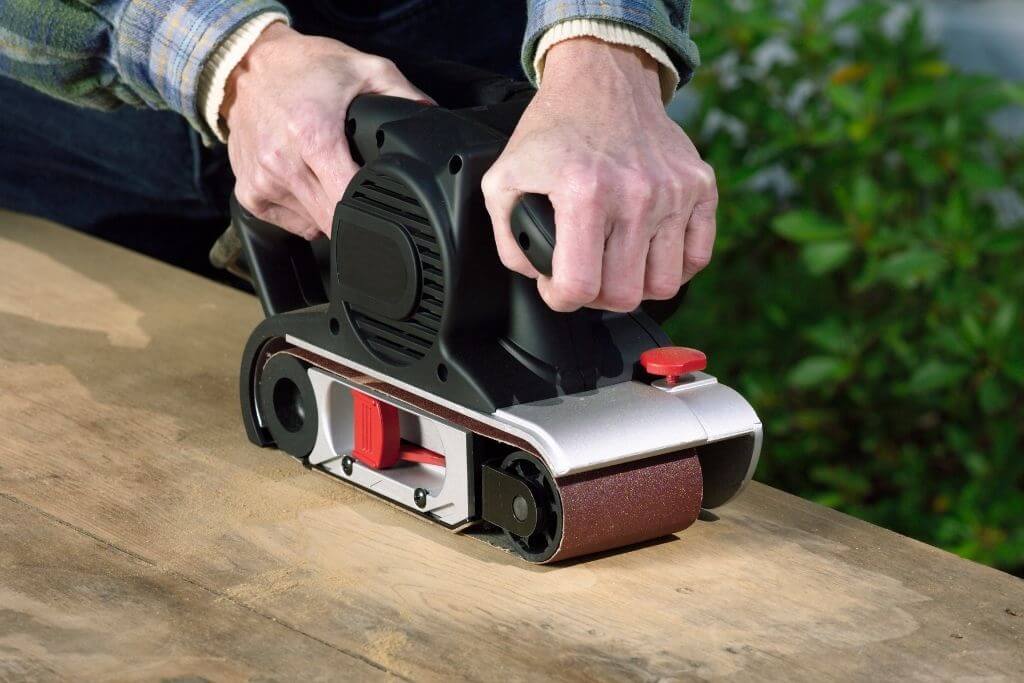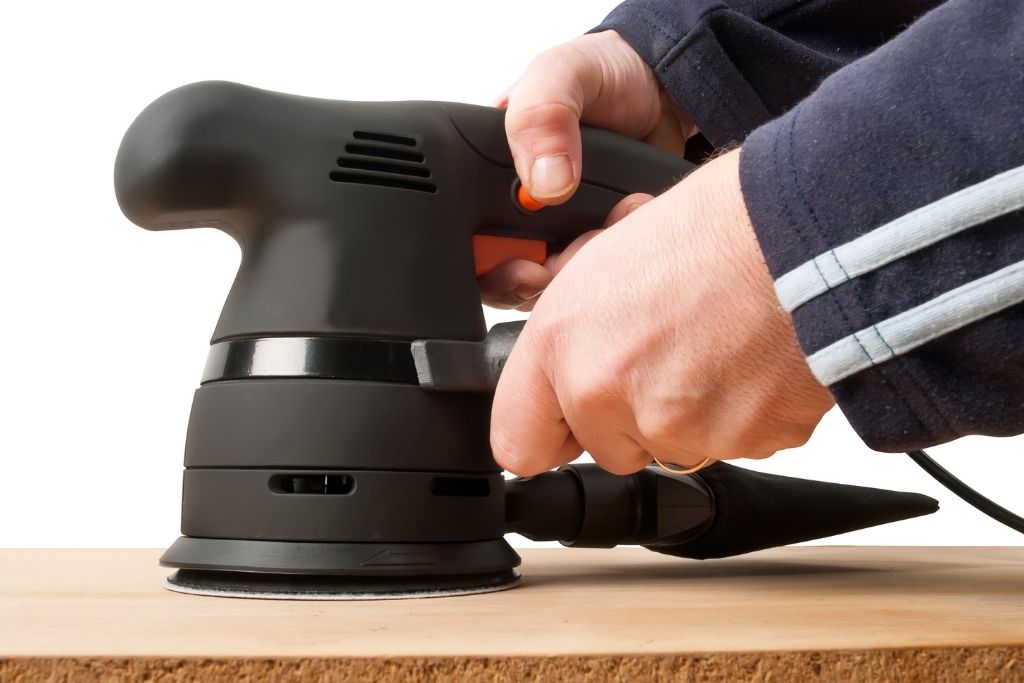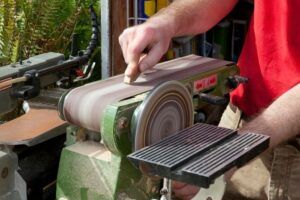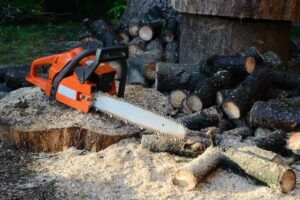
Woodworking is one of the most fun hobbies/professions we can take on. It is also rewarding to maintain the things we already own, like our trusty deck.
But, deck refinishing, a vital step in deck maintenance, requires you to have the best sander for deck.
While there are many types of sanders available, only some of them can fit well with deck restoration. That is why we prepare this guide to help you save time and effort.
Table of Contents
- Top Rated Sanders For Deck Refinishing Comparison
- Different Types Of Sanders For Deck Refinishing
- 6 Best Sanders For Deck Refinishing – Reviews
- How To Choose The Best Sander For Deck Refinishing
- Frequently Asked Questions About Sander For Deck
- Which Grit Is Best For Sanding Deck?
- How Do I Prepare The Deck For Sanding?
- How To Know If There Is Enough Sanding?
- Should The Deck Contact Water After Sanding?
- Can You Use A Floor Sander On The Deck?
- Will A Deck Sander Remove Paint?
- How Often Should You Sand A Deck?
- How Long Does It Take To Sand Your Deck With The Orbital Sander?
- Do You Need To Sand Your Deck Before Oiling?
- Conclusion
Top Rated Sanders For Deck Refinishing Comparison
Different Types Of Sanders For Deck Refinishing

Belt Sander
It is not an overestimation to call the belt sander the single most traditional type of sander. Its working principle is an imitation of how a human manually applies sandpaper to a wood deck surface.
A belt sander that can properly balance its belt around the mechanisms can make short work of any deck refinishing task.
After all, the belt can offer lots of abrasive contact with the wood surface. This sander type does have a weakness in its high weight, limiting its maneuverability.
Orbital Sander
Many choose a popular sander type for decking projects is the orbital sander. This sander utilizes a circular moving motion, which allows for a gentler sanding process.
As you may know, there should not be any damage to the wooden deck surface for the refinishing, so this motion can be quite beneficial.
Random Orbit Sander
The special feature of random orbit sanders is that they feature round pads, adding a new layer of movement into the sanding treatment.
This type of sander doesn’t just move circularly but also orbitally. As a result, there is much less risk of swirl marks forming.
This feature is especially useful for wooden deck refinishing, as swirl marks appearing at this step are usually hard to unfixable.
Disc Sander
The main job of disc sander is to finish projects off, so they tend to use sandpaper pads with finer sandpaper grits.
As a result, they can be used for deck refinishing. However, we don’t recommend using them if there are many gunk layers or debris on your deck.
Detail Sander
The best part about detailed floor sanders is clearly their triangular sanding smooth surface, which allows them to reach awkward crevices.
This ability lets you sand down the more intricate parts of the deck like railings or corners.
File Sander
While they can be used, the situation in which it is more beneficial to use file sanders is limited.
The most notable one is when there is a need for material removals in tight spaces on the deck. File sanders can easily reach there and provide enough abrasion to remove the debris with no damage.
6 Best Sanders For Deck Refinishing – Reviews
1. Makita BO5041K Random Orbit Sander

Specifications:
- Grit type: Medium
- Dimension: 7.5 x 16.3 x 10.3 inches
- Speed settings: Variable control (4000 to 12000 OPM)
- Amperage capacity: 3 Amps
- Power source: Corded Electric
- Voltage: 120V
- Orbit action: ⅛ inches
- Base size: 5 inches
- Weight: 3.09 pounds
- Vibration level: 3.5 m/s2
- Noise level: 81dB(A)
There are many boxes to check for an option to be considered the overall best sander for deck refinishing.
Of them, we believe comfort is something that you surely need, especially if you must sand an entire deck surface. The Makita BO5041K offers exactly this.
The secret behind this improved comfort is the ergonomically designed rubber palm grip. Kneeling to sand a whole deck is surely tiresome. This ergonomic design helps us reduce tiredness from the sander vibrating.
Not every sheet or random orbital sander offers the same comfort. The random orbital Dewalt model and the sheet Dewalt sander below do not have a similar grip.
Thanks to the 12000 OPM (orbits per minute) top speed, the tool has quite a quick sanding rate. It can make short work of all softwood types and most kinds of hardwood in exchange for strong vibrations.
However, the separate counterweight transfers most of the vibration toward the workpiece instead of the ergonomic handle. As a result, the vibration emission to your hands is only 3.5 m/s2, allowing an easier time maneuvering.
This maneuverability working together with the smallest small orbit size in this list of 1/8″ means you can reach most corners of the deck.
The tradeoff is, of course, you need to do more rounds, but once you enter top speed, one round doesn’t last long.
The biggest issue regarding this deck sander has to do with its shop vac port. This component is not only too small to fit most shop vac hoses. Its adapter is also lacking in depth.
- Comfortable to use thanks to pistol grip
- A soft start function to void swirl marks at the beginning
- Lightweight
- Variable speed control dial for more control of sanding
- Low vibration that suits for prolonged work
- Small shop vac port
- No detent in the speed knob
2. Makita 9403 Belt Sander
Specifications:
- Grit type: Medium
- Dimension: 9 x 16.1 x 9.76 inches
- Speed settings: No control (1,640 ft./min)
- Amperage capacity: 11 Amps
- Power source: Corded Electric
- Belt size: 4” x 24”
- Voltage: 120V
- Weight: 13 pounds
- Vibration level: 2.5 m/s2
- Noise level: 84 dBA
With today’s standards, most belt sanders are regarded as fairly crude. After all, they can easily tear up a wooden surface, are not easy to maneuver, etc.
These weaknesses are not present within the Makita 9403 Belt Sander, making it capable of handling more delicate projects.
The first thing that you will notice about this machine is that it is among the quietest belt sanders. You can work on your deck without disturbing your kids and pets inside the house.
Thanks to the noise reduction system that Makita specifically built for this sander, it never exceeds 84 decibels (dB) while working. This number is among the lowest on this list. With proper ear protection, there will be no damage to your ear.
Belt sanders are inherently faster at sanding flat surfaces like decks or doors, but the Makita 9403 takes this strength to the next level.
While offering only 1 option for sanding speed, it gives you 1,640 feet per minute, which is enough to sand down any surface.
Working with this speed is a huge belt 4” wide and 24” long, which increases the contact surface significantly. Instead of having to do 3 to 4 rounds to completely cover a deck surface with the above Makita model, now you only need to do 2.
This feature saves you a lot of time and effort, especially if you do big projects regularly. Also, its vibration level is only 2.5 m/s2, meaning you won’t feel much even if it works at full power.
The most notable weakness of this machine is the weight, as 13 pounds on your arm can significantly worsen your performance. However, once you familiarize yourself, this weight makes it easier to maneuver the sander.
- Quiet operation
- Terrific balance lessening the impact of its heavyweight
- High amp motor granting strong sanding performance
- Faster working time thanks to the wide belt
- Ergonomic front handle
- The vacuum system keeps clogging up
- Heavyweight
- The built-in dust bag is not airtight
3. DEWALT DWE6423K Random Orbit Sander
Specifications:
- Grit type: Coarse
- Item dimension: 10.38 x 7.25 x 6.2 inches
- Speed settings: Variable control (8000 to 12000 OPM)
- Amperage capacity: 3 Amps
- Power source: Corded Electric
- Orbit size: 3/32 inches
- Base size: 5 inches
- Voltage: 120V
- Weight: 3.93 pounds
- Vibration level: 2.5 m/s2
- Noise level: 91 dBA
Sanding is something that will always make a mess out of your working space. Due to the fast working speed and the lightness of the wood fibers, dust will be flying everywhere.
If you are not a fan of this problem, you need something good at dust collection, like the DEWALT DWE6423K. Swiping down a whole deck is easier with this model.
As we have mentioned, the dust collector is one of the biggest selling points of this machine. It doesn’t just collect wood dust but also fine paint, which is much smaller and more troublesome to take care of.
The internal collector will also transfer the dust to the bag through a port, allowing only a minimal amount of dust to escape.
That’s not all. You can attach and remove the dust bag with just one hand, providing a quick and efficient changing process. If you are not satisfied with the bag’s volume, you can pull it out and attach the port to a 1-1/4″ hose shop vac.
The max speed that this sander can go up to is 12000 OPM, while the minimum is 8000. With this speed, most surface types that you can encounter while refinishing decks won’t pose a problem. Also, both the switch and speed dial are dust-sealed, ensuring longer service life.
With a shorter design, you can get contact closer to a work surface. Also, you are forced to familiarize yourself with one-hand sanding, which takes a while to master.
It is also quite noisy while working, having a noise level of 91 decibels, which is enough to damage your ear. So you need to have the equipment to protect ears while using this model.
- Minimal setup process
- Shorter height makes it easier to approach the piece
- Incredible dust collection
- Less vibration
- Dust-sealed switch taking less damage from dust for a longer service life
- No attachment to secure the shop vac tightly to the dust port
- Difficult to access on/off switch
4. SKIL 7510-01 Pressure Control Belt Sander
Specifications:
- Grit type: Medium
- Item dimension: 12.25 x 6.25 x 5.75 inches
- Speed settings: No (1050 rpm)
- Amperage capacity: 6 Amps
- Power source: Corded Electric
- Belt size: 3″ x 18″
- Voltage: 120V
- Weight: 5.51 pounds
- Vibration level: 6.9 m/s2
- Noise level: 97 dBA
It goes without saying that most woodworkers start with a limited budget. As a result, they cannot put in as much for the sander, requiring something that offers the most bang for their buck. That is exactly what the SKIL 7510-01 Belt Sander stands for.
No matter where you get it, this machine’s price will always be less than the cost to rent another option for 24 hours.
However, you should never underestimate it, as it is surprisingly powerful due to its 6-amp motor. This motor lets the sander work at 1050 RPM, quite enough for most wood surfaces.
It is safer for beginners to use this model than the Makita 9403 above. While both tools only have one speed setting, this model has a pressure control tech.
Whenever you apply too much pressure, the warning light lights up, eliminating the risk of the machine destroying the surface.
Another interesting thing about this machine is the auto-track belt alignment. This feature keeps the belt centered throughout the process, ensuring that it will not stray out in any circumstance.
As such, it eliminates one of the biggest weaknesses that belt sanders have to face.
We note that the dust collection feature leaves a lot to be desired. This is not that much of a problem if you work outside, but it will be bad for indoor workshops.
- Affordable price
- Quick and easy sanding belt replacing process
- Auto-track belt alignment
- Pressure Control tech improves optimal finish
- Compatible with most vacuum hoses
- Dust collection not working efficient
- Small sanding head
- Awkward grip design
5. DEWALT DCW200B MAX XR Palm Sander

Specifications:
- Grit type: Fine
- Dimension: 9.34 x 5.96 x 6.21 inches
- Speed settings: Variable control (8000 to 14000 OPM)
- Amperage capacity: Cordless
- Power source: Battery Powered
- Base size: 1/4 sheet
- Voltage: 120V
- Weight: 2.86 pounds
- Vibration level: 3.52 m/s2
- Noise level: 83 dBA
Corded sanders are less maneuverable than cordless ones. The reason for this lack of mobility is the electric cord, which limits a huge range of movement.
However, the DEWALT DCW200B, being cordless, so it will have no issue reaching every nook.
The low profile height also works together with the square 1/4 sheet, allowing you to reach closer to the workpiece. Together, they allow you to sand every single detail there is on the surface.
This sander has a reliable paper clam design, which makes it easier to both install and secure the grip paper. At speed this sander goes, this secureness does wonders in ensuring the paper will not slip out.
As a result, there is less of a damage risk for the machine and also the wood surface.
We also want to note that at 2.86 pounds, this sander is clearly the single lightest option on this list. This lightness makes its already-strong maneuverability reach a new height.
Even if you hold it for a long time in an awkward position, you won’t feel as fatigued.
A huge weakness preventing cordless sanders from popularity is the lack of power due to the battery’s limitation time. However, you can use a 6Ah battery or larger for it.
With this battery, the sanding performance is fine to work along with the capacity variable speed between 8,000 – 14,000 OPM to suitable more sanding requirements.
Of course, while the battery is enough for most medium deck projects, it struggles when faced with heavy jobs.
Nonetheless, unless you are a top-tier woodworker, there are few projects requiring sanding for hours on end.
- Easy to get into corners
- Incredible maneuverability
- Dust-sealed switch
- Low profile height for precise sanding
- Powerful brushless motor and easy adjust speed
- Not suitable for heavy projects
- Dust particles collecting not as good
- Not include battery and charger
6. BOSCH GET75-6N Electric Orbital Sander
Specifications:
- Grit type: Various
- Item dimension: 15 x 6.3 x 5.5 inches
- Speed settings: no-load from 290 to 640 RPM, no load orbit from 3300 to 7300 OPM
- Amperage capacity: 7.5 Amps
- Power source: Corded Electric
- Orbit action: 0.36 inches
- Base size: 6 inches
- Voltage: 120V
- Weight: 5.7 pounds
- Vibration level: 5.5 m/s2
- Noise level: 86dB
There is no better way to address the BOSCH GET75-6N Electric Orbital Sander than the most flexible in this list.
Instead of allowing you only 1 choice for sanding style, it offers 2 modes. You can easily switch between each mode with a single switch flip.
If you only want a smoother finish, there is the normal random orbital mode. In this mode, the sander can freely alternate between 290 and 640 RPM. This speed allows for a gentler touch onto the surface, preventing any risk of damage.
On the other hand is the eccentric orbit mode, with which you can go on a no-load speed between 3300 and 7300 OPM.
This kind of power is more than enough to aggressively remove all stock before you can switch to the gentler mode. This combination can save quite a bit of time and effort for you.
Adding to this flexibility is the multi-hole pad system, which can accept quite a huge variety of abrasive discs.
Other options, such as the Makita and the Dewalt random orbital sanders, are peculiar about their pad requirements, but this electric sander can accept almost all sanding discs.
Nonetheless, you should keep in mind that this sander vibrates strongly. You may need to spend some time familiarizing yourself with this vibration to lessen the risk of damaging the surface.
- 2-in-1 sander providing incredible flexibility
- Powerful amp motor
- Compatible with many types of abrasive disc
- Relatively quiet operation
- Comfortable handle
- Expensive
- The sanding pad may come apart
- Difficult to find replacement pads
How To Choose The Best Sander For Deck Refinishing

Speed Options
There is no denying that speed is one of the most vital factors you should keep in mind while picking a sander. Most people who are new to sending think that faster is automatically better.
Nevertheless, fast speed is actually not always good, especially if it’s deck refinishing we are talking about.
A prime example of this notion is the deck railings, which require lighter touches. You must not exceed a certain threshold while working with these parts, or else there will certainly be swirl marks or other types of damage.
On the other hand, the actual deck slats are tough, so a higher speed is necessary to sand them down.
Experienced woodworkers can control the machine so that the same speed can fulfill both of these requirements. However, it takes quite a long time to master this pressure-controlling skill.
In the meantime, a machine with a variable speed control dial lets you compensate for this skill deficit.
Dust Collection
Sanding a whole deck is always a quite huge project, so the number of dust particles flying around will also be significant. Inhaling these particles may cause respiratory hazards.
Of course, you can protect yourself with eye protection and a dust mask, but they cannot cover all areas. That is why dust collection has always been a vital feature not just for sander but most power tools.
The first clear advantage of dust collection is you do not have to spend too much time cleaning up after each job. Secondly, you can now focus completely on the task at hand without worrying about the dust flying around.
Losing even 1 moment to clear the dust off the workpiece can disrupt your flow significantly. That is why it is absolutely worth it to get sanders that can collect dust for you.
Most dust collection features in sanders either attach themselves to vacuum cleaners, sucking all the dust into the machine. The other popular method is storing the dust in a dust bag.
Each of these methods has its own advantages and disadvantages. The shop vac attachment does not require you to stop sanding to empty the bag. However, it does limit your range of motion significantly.
The dust bag lets you freely move the sander around, but its limited capacity means lots of stops during the sanding process. There are, however, options allowing you to use both the bag and the connection, such as the DEWALT DCW200B Palm Sander.
Noise Level
Surprisingly, a huge number of people don’t know how loud sanding machines can be. However, the CDC actually suggests utilizing hearing protection while using them, alongside other power tools like chainsaws, lawnmowers, electric drills, etc.
We measure noise levels by using a meter of sound level, recording them in decibels (dBA). The higher this level is, the louder the noise will be. Sounds below 70 dBA are safe for long listening durations.
However, once they exceed 85 dBA, there is a risk of hearing loss if you listen to them for more than 8 hours. A rule of thumb is to cut the safe listening time by half with every rise of 3 dBA.
As a result, machines that produce 91 dBA sounds should not be used beyond 2 hours.
That is why we always stress the importance of protection from sander’s noise for your own good. There are 2 ways for you, investing in ear protection or searching for low-decibel sanders.
The first one can only protect your ear, but it will make noise for everyone around your work.
On the other hand, getting a sander with a nice noise suppression system is beneficial for everyone.
You do need to spend more time and effort while shopping, but the result will be very worth it.

Power Option
Most sanders operate with an electric cord, as its power supply is quite consistent. Nevertheless, managing cords in general and extension cords, in particular, is quite exhausting.
This hardship is increased even more if the position of your electrical outlets is awkward.
If you are not planning on taking on heavy projects that require sanding for hours on end, a cordless sander’s battery is more than enough. You can freely guide the sander any way you want.
Size
Most people don’t pay much attention to this aspect, but it can significantly alter the speed at which you perform sanding.
If the width of a sander is big enough, you can cut down the number of rounds you need to do. Nonetheless, if it’s too big, your sander will become clunky and hard to maneuver on the wood surface. You will also struggle to reach awkward corners.
The same is true for the height, as shorter heights let you approach the workpiece more. As such, you can have an easier time moving the sander and checking for damages, marks, etc.
Price
There is just no way to consider sanders a cheap investment, as they are power tools, and they should never be of low quality. After all, you get what you pay for. That doesn’t mean you cannot be smart with the way you spend the fund, though.
By taking into account everything you can regarding the deck refinishing project you would most likely take on, you can spend smartly.
For instance, if you only use the sander for deck refinishing, there is a high chance that it will operate only once a year. Getting a super-specialized sander, in this case, is just too wasteful. Instead, you should get one that can be used on other types of projects.
You should also consider the scale at which you hope your woodworking will be. If you will be doing only small projects like decks or rails, getting an industrialized sander is just a waste of money.
Something much lighter that can be used consistently throughout the year will suffice.
Also, large-scale sanders eat up a huge proportion of your electricity, so the money saved over some time will be huge.
That being said, if your deck happens to be made from a tough material like hardwood, it’s best to cough up some cash. You don’t want to wrestle with a weak sander against this kind of opponent.
Other features we have mentioned also have an impact on the price. Sanders with good dust compartments usually cost more. The same is true for those having variable speed options.
Frequently Asked Questions About Sander For Deck

Which Grit Is Best For Sanding Deck?
There is still a debate over the actual best grit paper for deck sanding. However, a popular recommendation is to use sandpaper between 60 and 80 grit to sand the primary surface.
Coarse grit is best at removing the deck’s initial finish. After you complete this step, you can change the speed setting to low and the grit to a finer degree for a smooth refinish.
How Do I Prepare The Deck For Sanding?
The first thing to do is to use a power washer and let it completely dry off. This step will allow your efficient sander to move smoothly on the deck’s surface.
Next, you should try to take out as many nails and screws as you can to lessen the risk of damage to your machine.
How To Know If There Is Enough Sanding?
A popular testing method to know if your sanding is enough is scribbling a light pencil line across the deck before beginning. When you don’t see the line anymore, change to the next grit.
Rinse and repeat until arrive at the highest grit, then use mineral spirits to check for no remaining marks.
Should The Deck Contact Water After Sanding?
The short answer is no. The deck should not contact any water under any circumstance after sanding is finished. If you wash your deck with water, the wood fibers will rise up. Now the surface will not be smooth enough for staining or oiling.
Can You Use A Floor Sander On The Deck?
It is possible to use floor sanders on your deck. Remember to be patient with it, go slow and steady to achieve the finish. It is quite tempting to go too fast with its large sanding base.
You should start with heavy grit sandpaper and move up gradually to finer to achieve a smoother finish.
Will A Deck Sander Remove Paint?
All sanders will remove the paint, as their job is to sand away the outermost layer of the wood where the paint is. They can also remove varnish and weatherproofing.
How Often Should You Sand A Deck?
It depends on how often you want to re-apply your stain or oil. You should replace water-based stains after 2 or 3 years and oil your deck every year. Before doing either of those things, you need to sand your deck.
How Long Does It Take To Sand Your Deck With The Orbital Sander?
The duration of this process depends on the size and the current conditions of your deck.
With a belt sander for the decking and an orbital sander for the handrail, a standard deck of 300 square feet may take over 8 hours to sand. If you only use an orbital sander, expect at least a few more hours.
Do You Need To Sand Your Deck Before Oiling?
It is absolutely necessary to sand your deck before applying oil to it. After all, there may be lots of splinters and damages on the wood surface to get rid of.
Conclusion
After going through our buying guide for the best sander for deck, we will round up a clear winner to save you some time.
We believe that the Makita 9403 Belt Sander is the clear best choice. It has one of the best features a sanding machine can have, a counterweight system well balanced.
You don’t feel any vibration on your hands, allowing for a much more natural and easier sanding process. It also has a good noise suppression system.
Due to the nature of belt sanders, this machine is much faster than sheet sanders and random orbital ones.
There is no need to worry about damages either. It has a starts soft for smooth operation. As a result, it almost does not have any weakness of a typical belt sander but has all of the strengths.
The runner-up is the BOSCH GET75-6N Electric Orbital Sander. It offers unique flexibility that is simply not seen in any other competitor. You can quickly switch between the 2 modes with the flick of a finger. However, the vibration it produces can be too much for newer woodworkers.
For sanding the handrail, we recommend the Makita BO5041K. Its random orbital movements reduce the risk of swirl marks. The extra grip also helps in terms of control.
In summary, different sanders serve different purposes. Belt sanders scrub off the decking quickly. Random orbital ones are for a smooth handrail.
You should pay attention to the sanding surface, the motor, and the dust collector of your candidates.









![How To Start A Woodworking Business [Ultimate Guide] How To Start A Woodworking Business [Ultimate Guide]](https://handykeen.b-cdn.net/wp-content/uploads/2021/10/woodworking-business-1-300x200.jpg)
